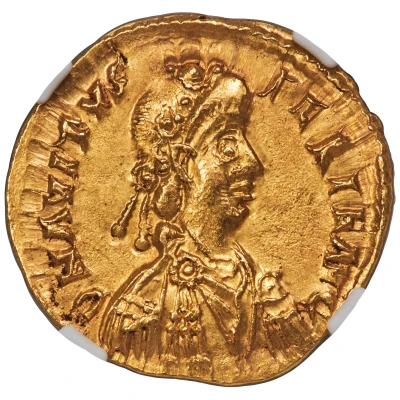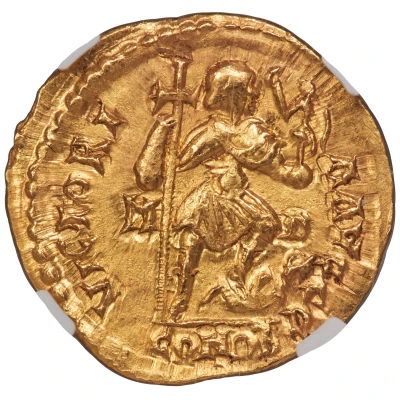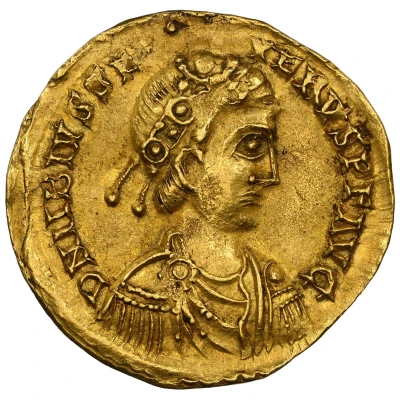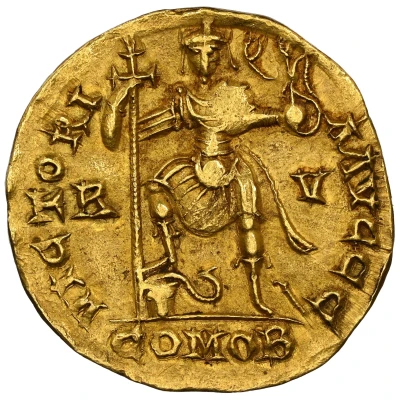
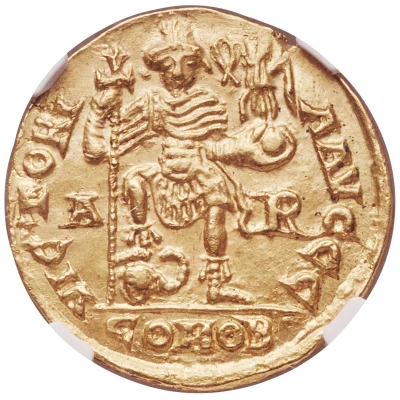

© Heritage Auctions
Solidus - Majorian VICTORIA AVGGG; Arelate
| Gold | 4.57 g | 22 mm |
| Issuer | Western Roman Empire (Rome) |
|---|---|
| Emperor | Majorian (457-461) |
| Type | Standard circulation coin |
| Years | 457-461 |
| Value | 1 Solidus |
| Currency | Solidus |
| Composition | Gold |
| Weight | 4.57 g |
| Diameter | 22 mm |
| Shape | Round (irregular) |
| Technique | Hammered |
| Orientation | Variable alignment ↺ |
| Demonetized | Yes |
| Updated | 2024-10-04 |
| Numista | N#373850 |
|---|---|
| Rarity index | 97% |
Reverse
Majorian, draped, cuirassed, standing front, holding long cross in right hand and Victory on globe in left hand; placing right foot on head of human-headed serpent.
Script: Latin
Lettering:
VICTORI-A AVGGG
A R
COMOB
Comment
The last heroic character to occupy the western Roman throne, Flavius Julius Valerius Majorianus was born ca. AD 420 to an aristocratic Roman family. His mother was daughter of the elder Majorianus, who served as Master of Soldiers to Theodosius I (AD 379-395), while his father was a financial officer during the long reign of Valentinian III (AD 430-455). Majorian entered military service at an early age and distinguished himself in battle, as well as cutting a dashing figure at court. When Valentinian III was murdered in AD 455, his widow Licinia Eudoxia favored Majorian as his replacement, but was outmaneuvered by the usurper Petronius Maximus. Majorian then allied himself with the powerful barbarian general Ricimer, master of soldiers under the emperor Avitus, whom they deposed late in October of AD 456. After a six-month "interregnum," Majorian was hailed as emperor by Ricimer and his troops on 1 April AD 457. His letter to the Roman Senate setting forth his military and domestic policies is one of the few reliable documents to have survived from this shadowy period. Majorian spent most of the next two years leading military expeditions into Spain and Gaul, regions that had virtually broken away from Roman authority. Defeats were dealt to the Visigoths, Burgundians, and Vandals, the first such Roman victories in decades. Coinage struck in his name by the Visigoths (including this rare gold solidus) show his efforts met with considerable success. He next prepared to launch an invasion of North Africa to eject the Vandals from their home base, but before he could embark, the Vandals attacked and captured his fleet at Cartagena late in AD 459. The disaster fatally crippled Majorian's regime. Forced to conclude a humiliating peace treaty, Majorian attempted to return to Italy. But after dismissing his bodyguard in Gaul, he was intercepted, arrested and executed by his former ally Ricimer, who appointed the docile Libius Severus in his stead.Interesting fact
One interesting fact about this coin is that it features the first known use of the "V" letter in the Latin alphabet, which was previously written as "U" or "VV" in Roman inscriptions. The "V" letter was introduced by the Emperor Majorian himself, who was a Gothic king that ruled the Western Roman Empire from 457 to 461 AD. This innovation in the Latin alphabet paved the way for the modern "V" letter that we use today.
